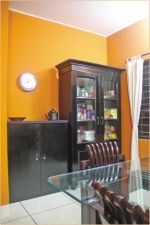DECOR

WALL makeovers
The term 'wall covering' includes an enormous variety of designs, patterns and colours, as well as texture and finishes. Careful selection and application is the key and given the options, it should always be possible to find a covering to complement perfectly the atmosphere you are aiming to create.
The walls and ceilings of your rooms can be enhanced in many ways: for example, with decorative wood or plaster mouldings, wall panelling, different types of colour, wall paper or fabric covering and paintings and photographs.
 Plaster mouldings are a time-tested technique. Classical architectural also exhibits use of plaster mouldings, floral patterns or geometric patterns on wall coverings. Figurative work was being replaced with a lighter and more playful Rococo style in the 1700s. This became particularly widespread in Ireland. Decorations were strung across the ceiling with an emphasis on the asymmetrical and picturesque designs while using acanthus leaves, festoons, swags and baskets of fruits and flowers with the occasional zoomorphic touch of birds and dragons, which became extremely popular in the 1760s.
Plaster mouldings are a time-tested technique. Classical architectural also exhibits use of plaster mouldings, floral patterns or geometric patterns on wall coverings. Figurative work was being replaced with a lighter and more playful Rococo style in the 1700s. This became particularly widespread in Ireland. Decorations were strung across the ceiling with an emphasis on the asymmetrical and picturesque designs while using acanthus leaves, festoons, swags and baskets of fruits and flowers with the occasional zoomorphic touch of birds and dragons, which became extremely popular in the 1760s.
This week's column features the home of a very close friend of mine. She is a sociologist with a keen interest in home decor. An important part of the decor of her house is the abundant use of colour. Each room has a character of its own through colour palette distinction.
Colour is the most versatile tool a designer can employ. It is both the easiest way to improve space and an effective way to alter it. It is the most exciting decorating element. The palette for walls is often white or cream -- colours that work well as a backdrop for richer hues. Aside from the strength of colour itself, the enormity of colour choices available in paints, wallpapers, fabrics, and flooring options can overwhelm us, making us retreat to the safety of white or neutral walls. However, a little experimentation can often break monotony and liven up a room with minimal effort. My friend used green for the walls in her living room. She also used light beige and green leaves made from printed fabric for curtains and a traditional shitolpatti for the floor. Green never looks out of place- for its position at the center of the rainbow means it is in harmony with all other colours. Its close connection with nature helps to link us to the cycle of life so that we can relax and go with the flow. Green refreshes and cleanses our hearts and minds and generates a source of renewed energy.
The family living room makes use of different shades of purple, from light purple to deep purple. The furniture consists of cane sofa sets with deep purple handloom fabric for cushion covers. White jamdani curtains create a refreshing contrast against the purple walls. Decorating with purple usually requires forethought and caution. The colour is unusual in terms of decor and it can be tricky to design an entire room in purple. However, using a purple colour scheme will undoubtedly add a rich, luxurious feel to a home, giving a dramatic makeover to ordinary settings. In order to create a balanced visual impact, one can use moulding beats and white cornices.

Cornices have always been one of the most impressive decorative plaster features. They were originally used externally in classical architecture at the edges of roofs, but were soon also used inside on the perimeter of ceilings. As with panel mouldings, a huge range of profiles are available, from authentic Greek and Roman forms through 18th and 19th century styles, featuring classic motifs such as acanthus, dentil, swag-and-drop and egg-and-dart. Plain concave mouldings known as covings are also available, made either as paper-faced mouldings with plaster cores or made from wood. Timber mouldings are made with shaped cutters and routers to produce a wide range of cross sections.
NAZNEEN HAQUE MIMI
Interior Consultant
JOURNEYMAN
E-mail: journeyman.interiors@gmail.com
Photo Credit: Tamim Sujat
Special thanks to: Snigdha Ali
